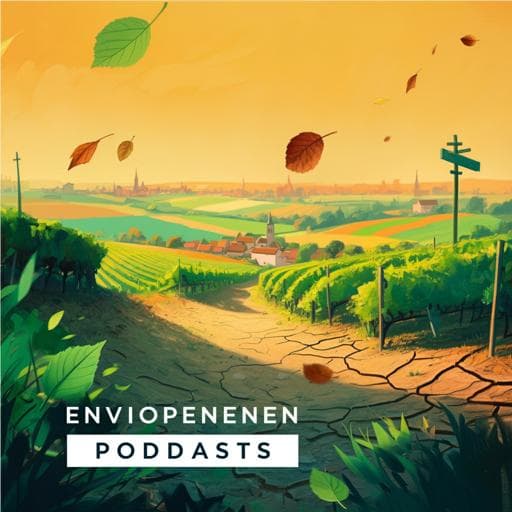
Earth Sciences
Continuous increase in evaporative demand shortened the growing season of European ecosystems in the last decade
M. Rahmati, A. Graf, et al.
Recent research by Mehdi Rahmati and colleagues reveals a surprising reversal in the length of European growing seasons, potentially challenging our understanding of climate impacts. While early greening continues, trends indicate a shortening of the season back to levels not seen since the 1980s, primarily due to increased atmospheric water demands in summer. Discover the implications for ecosystem management in this cutting-edge study.
~3 min • Beginner • English
Introduction
The study investigates how climate change has altered vegetation phenology in Europe, focusing on the onset of greening (OG) in spring, onset of dormancy (OD) in autumn, and the resulting growing season length (GSL) from 1982 to 2020. While warming has generally advanced OG in the Northern Hemisphere, the response of OD has been inconsistent across studies. The authors aim to assess whether previously reported lengthening of the European growing season has persisted, identify meteorological and hydrological drivers of any shifts (temperature, precipitation, vapor pressure deficit, soil moisture), and disentangle the roles of water and energy supply. The work is important because changes in GSL affect ecosystem productivity, carbon balance, and land–atmosphere exchanges.
Literature Review
Prior research indicates earlier OG associated with warming from ground and satellite observations. However, OD responses are mixed: some report delays due to increased enzyme activity, reduced chlorophyll degradation, reduced frost exposure, and enhanced growth capacity under higher temperatures; others report earlier OD linked to leaf lifespan constraints or late-season water deficits. Earlier spring greening and elevated spring evapotranspiration have been linked to additional summer soil moisture deficits (1982–2011), potentially advancing OD. Yet precipitation variability and atmospheric water demand (VPD) can also govern OD, complicating attribution. Earlier global and European analyses (often up to ~2010) generally reported lengthening GSL (e.g., 0.8–0.96 days/year), but more recent evidence suggests these trends may be weakening when including the last decade.
Methodology
Data and scope: The study analyzed Europe-wide phenology from 1982–2020 at 0.25° spatial resolution using multiple NDVI products and reanalysis datasets.
NDVI and phenology extraction (LFD-NDVI): OG and OD were derived from GIMMS NDVI (1982–2015), AVHRR NDVI (1982–2017; 2018–2020 excluded for quality), and MODIS NDVI (2001–2020). All NDVI series were aggregated to monthly resolution. A novel logistic-function-derivative NDVI (LFD-NDVI) method was introduced: cumulative, rescaled NDVI curves were fit with a logistic function; curvature analysis identified three phases (winter dormant, active growth, fall dormant). Bisectors between linear approximations of adjacent phases intersected the logistic curve to determine OG (transition from winter dormant to growth) and OD (transition from growth to fall dormant). To harmonize products, OG and OD from MODIS and AVHRR were linearly scaled to match GIMMS using land-cover-specific scaling factors estimated over common periods (GIMMS–MODIS: 2001–2015; GIMMS–AVHRR: 1982–2015), then averaged across products for analysis.
Reanalysis and ancillary data: Meteorological and hydrological drivers included air temperature (T), precipitation (P), vapor pressure deficit (VPD), surface soil moisture (SSM), and root-zone soil moisture (RSM) from GLDAS Noah v2.0 (to 2014) and v2.1 (2001–present; bias-adjusted to v2.0 climatology via site/day-of-year regression), ERA5-Land (downloaded at daily, 0.25°), and GLEAM v3.6a (daily). GLDAS 3-hourly data were averaged to daily. Variables available from multiple products (e.g., ET, SSM) were combined via PCA using the first principal component when needed. All datasets were spatially aggregated to 0.25° using RegularGridInterpolator and validated to minimize smoothing (std dev reduction <5%; moving-window Nash–Sutcliffe efficiency >0.95).
Validation: Reanalysis ET and SSM were compared with FLUXNET2015 station observations over overlapping periods (2000–2009, 2010–2020). ET correlations ranged 0.59–0.87 (2000–2009) and 0.64–0.91 (2010–2020). SSM correlations were weaker (0.24–0.60 and 0.07–0.83), reflecting measurement uncertainties. Phenology was not directly validated against in-situ phenology networks due to scale mismatch; prior MODIS–PhenoCam comparisons showed strong agreement (R≈0.81) except for evergreen needleleaf forests.
Temporal windows for drivers: For each pixel and year, variables were averaged over five periods relative to phenology: winter (Jan 1 to 30 days before OG), early spring (30 days before OG to OG), spring (OG to peak greenness, PG), summer (PG to 14 days before OD), and late summer (14 days before OD to OD). Long-term anomalies were computed for modeling.
Trend analyses: Pixel-wise trends in OG, OD, and GSL (1982–2020) were tested using the Mann–Kendall test (original and Theil–Sen slope) with AR(1) correction for autocorrelation (pyMannKendall; alpha=0.05). Periodic analyses summarized trends by decades (1982–1990, 1991–2000, 2001–2010, 2011–2020). A moving 15-year window (ending years from 1996 to 2020) assessed the timing of trend reversals.
Driver attribution: A pixel-wise Group Method of Data Handling (GMDH) gray-box modeling approach selected the top two predictors among anomalies of T, P, VPD, SSM, and RSM across the defined seasonal windows to explain anomalies in OG, OD, and GSL. Models were trained/tested with 70/30 splits repeated 100 times, retaining runs with evaluation R≥0.7 to identify primary and secondary controls. Principal component analysis (PCA) biplots characterized the direction of associations between phenology and drivers. Results were also summarized by dominant land-cover classes.
Key Findings
- Spatial GSL: Long-term mean GSL (1982–2020) increases toward lower latitudes, reaching ~220 days, and is shorter at higher latitudes (~120 days).
- Onset of greening (OG): Significant earlier OG trends in 35% of pixels; mean shift ~11 days earlier (mid-April in 1982–1990 to early April in 2011–2020). In 63% of pixels, no significant OG trend, with up to ~3 days earlier. Only 2% showed significantly later OG (mean delay ~16 days).
- Onset of dormancy (OD): OD trends are more complex: 73% of pixels show no significant trend (around October 13). Earlier OD in 17% of pixels (mid-October to early October from 1982–1990 to 2011–2020); later OD in 10% of pixels.
- Growing season length (GSL): 65% of pixels show no significant GSL trend (stable at ~185±1 days). GSL lengthened over 28% of pixels by ~13 days on average (177→190 days) and shortened over 7% by ~16 days (194→178 days). Overall European average increase is ~0.3 days/year over 1982–2020—about one third of earlier reports for shorter periods.
- Decadal trend evolution: Mean European GSL trend slopes: +0.43 d/y (1982–1990), +0.35 d/y (1991–2000), ~0 with a tendency negative (2001–2010), and −0.12 d/y (2011–2020), offsetting about one-third of earlier lengthening. Similar pattern (early positive, recent negative) in croplands, evergreen needleleaf forests, and grasslands. Strongest negative trend in 2011–2020 observed in grasslands (−0.50 d/y); croplands and evergreen needleleaf forests showed substantial negative tendencies (~0.29 d/y in magnitude). Some classes (wooded tundra, mixed forests) continued lengthening.
- Timing of reversal: Moving 15-year window analysis shows GSL trend reversal begins after 2003–2004 (coinciding with the 2003 European drought). GSL trends remain positive but weakening until 2013–2014, then turn negative after 2014. In 2011–2020, OD advanced at −0.31 d/y and OG still advanced but more slowly (−0.19 d/y), jointly shortening GSL.
- Drivers of phenology and GSL: Air temperature (AT) and atmospheric VPD (AVPD) dominate controls. For GSL, late-summer AT is the most frequent primary control (~28% of pixels; also frequent secondary), early-spring/spring AT also critical (first/second control for ~12% and ~8%). AVPD in late summer is a frequent primary (~16%) and secondary (~10%) control; across seasons AVPD is the first/second control in ~29%/~22% of pixels. Precipitation (AP) ranks next (primary ~10%, secondary ~15%). Surface and root-zone soil moisture anomalies (ASM: SSM and RSM) exert the least influence.
- OG controls: Early-spring AT and AVPD are the most important controls for OG; OG is negatively correlated with winter/early-spring T, VPD, and P (higher values lead to earlier OG); little correlation with SSM/RSM.
- OD controls: Summer/late-summer AT and late-summer AVPD are the dominant controls for OD; OD is negatively correlated with summer/late-summer T and VPD (higher values lead to earlier OD) and positively with P (more P delays OD); minimal correlation with SSM/RSM.
- Spatial patterns: For OG, T, VPD, and P dominate with VPD more prominent in coastal areas below ~60°N, P in central Europe, and T elsewhere. For OD, T and VPD dominate across Europe with some role for P; SSM/RSM are weak controls in both OG and OD maps.
- Land-cover differences: High-latitude tundra types strongly drive OG advances (high temperature sensitivity). Earlier OD is driven primarily by croplands and grasslands, which have shallower roots and are sensitive to high late-summer AT and VPD and management (e.g., earlier harvest in croplands).
Discussion
The study shows that while spring greening in Europe has continued to advance, the rate has slowed in recent years. Crucially, a distinct shift to earlier dormancy during 2011–2020 shortened the growing season, bringing average GSL back toward 1980s levels. The attribution analyses indicate that increased atmospheric water demand (higher temperatures and VPD), especially in late summer, has become the dominant constraint leading to earlier OD, even when soil moisture anomalies do not indicate widespread deficits at the seasonal scale. Thus, atmospheric demand rather than soil water availability per se increasingly limits transpiration, promoting earlier physiological downregulation and senescence. This reconciles the apparent contradiction of continued early OG with overall GSL shortening and supports the hypothesis that water–energy demand dynamics, not just soil moisture supply or precipitation deficits, are now key drivers. The timing analysis links the reversal to the mid-2000s (post-2003 drought) with clearly negative trends after 2014, suggesting climate extremes and sustained warming have altered phenological controls. These changes imply significant impacts on ecosystem productivity, carbon uptake, and land–atmosphere water and energy exchanges, especially in grasslands and croplands that exhibit the strongest recent GSL declines.
Conclusion
Using a new LFD-NDVI method harmonizing multiple satellite records, the study documents a Europe-wide reversal of previously lengthening growing seasons: despite continued earlier spring greening, increased atmospheric water demand in summer since the 2010s has advanced dormancy and shortened GSL, returning to lengths comparable to the 1980s in many regions. Temperature and VPD in late summer (and temperature in early spring/spring) are the predominant controls on GSL, while soil moisture anomalies play a comparatively minor role at the analyzed scales. The findings highlight the growing importance of atmospheric demand constraints on vegetation function under warming, with implications for carbon balance and water–energy fluxes.
Future research should: (i) assess post-2020 trends amid recent extreme heat/drought years; (ii) incorporate higher-resolution and crop-specific data to separate management effects (e.g., harvest timing, irrigation) from climate-driven phenology; (iii) improve characterization of evergreen needleleaf seasonality; (iv) integrate species- and site-level phenology with satellite products; and (v) explore mechanistic stomatal and hydraulic thresholds under high VPD conditions to better predict OD responses.
Limitations
- Spatial and temporal scale: Analyses at 0.25° resolution may mask local heterogeneity, management practices (e.g., harvest timing, irrigation), and species-specific responses. Harvest timing for croplands could not be explicitly assessed.
- Validation constraints: Direct comparison with in-situ phenology networks was not feasible due to scale mismatch; evergreen needleleaf forests have known lower agreement between satellite and camera-based phenology.
- Soil moisture uncertainties: Reanalysis SSM correlated weakly with FLUXNET SSM at some sites, reflecting measurement and representativeness issues; root-zone moisture is model-derived and uncertain.
- Dataset harmonization: Differences between GLDAS v2.0 and v2.1 forcings required regression-based climatology matching; AVHRR 2018–2020 excluded for quality concerns; product scaling to GIMMS introduces additional uncertainty.
- Methodological assumptions: The LFD-NDVI approach assumes identifiable linear segments in cumulative NDVI and uses bisector intersections to define OG/OD; systematic uncertainties remain, though trend analyses should be robust. VPD and temperature averages over fixed windows may not capture short extreme events that influence phenology.
Related Publications
Explore these studies to deepen your understanding of the subject.







